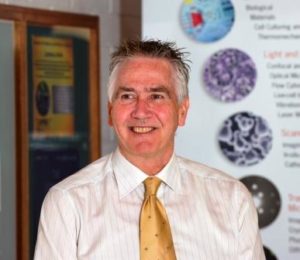
In a world first, a Flinders University forensic scientist has found promising indications that isotopes in gunshot residue could provide a previously unachievable level of detail about gun crimes in the absence of a firearm or spent bullet cartridge.
Professor Paul Kirkbride, a former Assistant Director at Forensic Science SA and Chief Scientist at the Australian Federal Police, said the isotopes, contained in minute glass fragments left behind when a gun is fired, could hold the key to identifying which brand of ammunition was used – and even definitively link it to the shooter.
The availability of such evidence could be a game changer for law enforcement agencies previously unable to link some shooters with crime scenes.
The isotope analysis, which is focused on .22 ammunition (the most commonly used ammunition in gun crimes in Australia), is the second, and most intricate, phase yet of Professor Kirkbride’s already unrivalled work.
The Flinders University based researcher has already utilised Time of Flight Secondary Ion Mass Spectrometry, or ToF-SIMS, used in analysing surfaces with extreme sensitivity, including mineral particles in mining, to examine the make-up of tiny fragments of glass present in the primer of bullet cartridges.
That work brought him together with Professor Bill Skinner of the University of South Australia’s Ian Wark Research Institute which, at the time, possessed the only ToF-SIMS in Australia.
Further research, still involving Professor Skinner and ToF-SIMS Technologist John Denman, is being carried out to move this technique closer to actual implementation in casework.
But to take the science of gunshot residue examination to a new level, Professor Kirkbride, whose research is funded by the South Australian Government, is now using a Sensitive High Resolution Ion Microprobe (SHRIMP) in conjunction with Geoscience Australia and Australian Scientific Instruments, who developed and manufacture the massive piece of equipment.
“What we’re seeing is evidence that there are measureable isotopic characteristics in the glass fragments. It’s like a fingerprint, which doesn’t change before, during or after the gun is fired.
“The significance of this is that after firing a gun, these glass residues could be left on the shooter and in the wound of the victim, and these residues will match the ammunition used by the shooter,” said Professor Kirkbride.
“The isotope fingerprint carries clues as to the particular geographical origin of the minerals that make up the glass and we expect that this will point us towards the factory or country of origin of the ammunition.
“If we are able to prove that a suspect owns, or has bought, the ammunition which matches the gunshot wound, that would be an incredibly valuable – and previously unachievable – piece of information for law enforcement agencies.”

